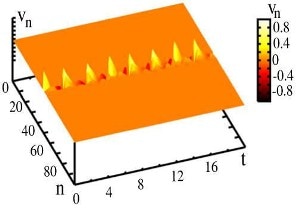Oct 27 2016
Supersonic solitary waves in nano-electronics crystals show potentials for electric charge or matter transport and energy storage with extremely low heat dissipation
 Supersonic solitary waves in nano-electronics crystals show potentials for electric charge or matter transport and energy storage with extremely low heat dissipation Freak waves, as well as other less striking.(Credit: EPJ)
Supersonic solitary waves in nano-electronics crystals show potentials for electric charge or matter transport and energy storage with extremely low heat dissipation Freak waves, as well as other less striking.(Credit: EPJ)
Freak waves, as well as other less striking localised excitations, occur in nature at every scale. The current theory and models of such waves can be applied to physics and, among others, to oceanography, nonlinear optics and lasers, acoustics, plasmas, cosmological relativity and neuro-dynamics. However, they could also play a significant role at the quantum scale in nano-electronics. In a recent study, Manuel G. Velarde from the Pluridisciplinary Institute of the University Complutense of Madrid, Spain, and colleagues, performed computer simulations to compare two types of localised excitations in nano-electronics. Their findings, published in a recent study in EPJ B, confirm that such localised excitations are natural candidates for energy storage and transport. These, in turn, could lead to applications such as transistors with extremely low heat dissipation not using silicon.
Spontaneously localised excitations may either be pinned to the crystal lattice--known as discrete breathers--or alternatively may travel, and are then referred to as solitons or spontaneous solitary excitation waves. To further clarify the differences between the two types of excitations, the authors developed a computer simulation. They relied on the direct integration of their dynamics (using an approach known as the standard Runge-Kutta methodology), following a strong initial external pulse on a single lattice unit.
The authors focused on the relative influence of the forces leading to these excitations as a result of on-site and inter-site vibrations (corresponding to individual lattice units and relative displacements of units, respectively). Under certain conditions, they found that the discrete breathers evolve into a genuine soliton, moving at supersonic speed within the lattice.
These findings confirm that solitons can be used as natural carriers of energy, matter or electric charge--in the latter case, by transferring the soliton-like motion to the charges, allowing them to 'surf' on the soliton wave. Meanwhile, discrete breathers are natural energy traps for energy and can also be used as electric charge carriers under certain conditions.